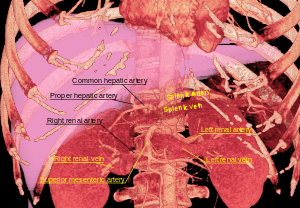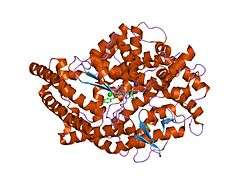Renovascular hypertension
Renovascular hypertension is a condition in which high blood pressure is caused by the kidneys' hormonal response to narrowing of the arteries supplying the kidneys.[1] When functioning properly this hormonal axis regulates blood pressure. Due to low local blood flow, the kidneys mistakenly increase blood pressure of the entire circulatory system. It is a form of secondary hypertension - a form of hypertension whose cause is identifiable.[3][4]
| Renovascular hypertension | |
|---|---|
| Other names | Renal hypertension |
 | |
| 3D rendered CT of abdominal aortic branches kidneys | |
| Specialty | Cardiology, nephrology |
| Risk factors | Diabetes, High cholesterol[1] |
| Diagnostic method | Blood and urine test[2] |
| Treatment | Antihypertensive, Stress reduction[1] |
Signs and symptoms
Symptoms of renovascular hypertension include the following:[1]
- High blood pressure (early age)
- Kidney dysfunction
- Narrowing of arteries elsewhere in the body
- Pulmonary edema
Cause
The cause of renovascular hypertension is consistent with any narrowing/blockage of blood supply to the renal organ (renal artery stenosis). As a consequence of this action the renal organs release hormones that indicate to the body to maintain a higher amount of sodium and water, which in turn causes blood pressure to rise. Factors that may contribute are: diabetes, high cholesterol and advanced age,[1] also of importance is that a unilateral condition is sufficient to cause renovascular hypertension.[5]
Pathogenesis

The pathogenesis of renovascular hypertension involves the narrowing of the arteries supplying the kidneys which causes a low perfusion pressure that is detected by the juxtaglomerular apparatus (via the macula densa cells, which act as baroreceptors; located on the afferent arteriole wall).[6] This leads to renin secretion that causes the angiotensinogen conversion to angiotensin I. Angiotensin I then proceeds to the lung where it is converted to angiotensin II via angiotensin converting enzyme (ACE).
In most people fibromuscular dysplasia or atherosclerosis is the reason for the occlusion of a renal artery which ultimately leads to this condition.[7]
Diagnosis
The diagnosis for renovascular hypertension is done by:[2]
- Blood test (for renal function)
- Urinary test (tests for microalbuminuria)
- Serology (to exclude systemic lupus erythematosus )
- Lipid profile
- Urinalysis (to exclude presence of red blood cells)
Treatment
In terms of treatment for renovascular hypertension surgical revascularization versus medical therapy for atherosclerosis, it is not clear if one option is better than the other according to a 2014 Cochrane review; balloon angioplasty did show a small improvement in blood pressure .[8]
Surgery can include percutaneous surgical revascularization, and also nephrectomy or autotransplantation, and the individual may be given beta-adrenergic blockers.[9] Early therapeutic intervention is important if ischemic nephropathy is to be prevented. Inpatient care is necessary for the management of hypertensive urgencies, quick intervention is required to prevent further damage to the kidneys.[10]
Prognosis
Prognosis of individuals with renovascular hypertension is not easy to determine. Those with atherosclerotic renal artery disease have a high risk of mortality, furthermore those who also have renal dysfunction have a higher mortality risk. However, the majority of renovascular diseases can be improved with surgery.[4]
References
- MedlinePlus Encyclopedia Renovascular hypertension
- "Renovascular Disease. Learn about Renovascular Disease | Patient". Patient. Retrieved 2015-09-30.
- Textor, Stephen C. (2014). "Secondary hypertension". Journal of the American Society of Hypertension. 8 (12): 943–5. doi:10.1016/j.jash.2014.10.007. PMID 25492839. – via ScienceDirect (Subscription may be required or content may be available in libraries.)
- Renovascular Hypertension at eMedicine
- Antman, Elliott M. (2007-01-01). Cardiovascular Therapeutics: A Companion to Braunwald's Heart Disease. Elsevier Health Sciences. p. 615. ISBN 978-1416033585.
- Rosenthal, J.; Arlart, I.; Franz, H. E. (2012). "Renovascular Hypertention". In Rosenthal, Julian (ed.). Arterial Hypertension: Pathogenesis, Diagnosis, and Therapy. Springer. pp. 201–202. ISBN 978-1-4612-5657-1.
- Lip, Gregory Y. H.; Hall, John E. (2007-06-28). Comprehensive Hypertension. Elsevier Health Sciences. p. 101. ISBN 9780323070676.
- Jenks, Sara; Yeoh, Su Ern; Conway, Bryan R; Jenks, Sara (2014). "Balloon angioplasty, with and without stenting, versus medical therapy for hypertensive patients with renal artery stenosis". The Cochrane Database of Systematic Reviews. 12 (12): CD002944. doi:10.1002/14651858.CD002944.pub2. PMID 25478936. Lay summary – Cochrane (December 5, 2014).
- Illustrated Manual of Nursing Practice. Lippincott Williams & Wilkins. 2002-01-01. p. 638. ISBN 9781582550824.
- Renovascular Hypertension~treatment at eMedicine
Further reading
- Advances in Renal Hypertension Research and Treatment: 2012 Edition: ScholarlyPaper. ScholarlyEditions. 2012-12-26. ISBN 9781481636018.
- Textor, Stephen C. (2009). "Current Approaches to Renovascular Hypertension". Medical Clinics of North America. 93 (3): 717–32, Table of Contents. doi:10.1016/j.mcna.2009.02.012. PMC 2752469. PMID 19427501.
- Mehta, Ankit N.; Fenves, Andrew (2010). "Current opinions in renovascular hypertension". Proceedings. 23 (3): 246–9. doi:10.1080/08998280.2010.11928627. PMC 2900976. PMID 20671820.
External links
| Classification | |
|---|---|
| External resources |